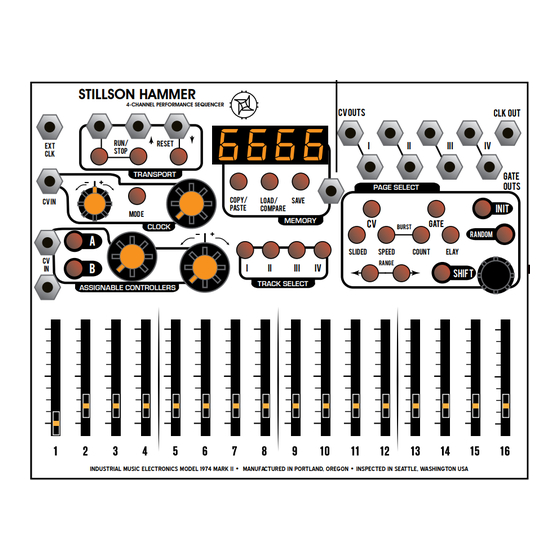
Table of Contents
Advertisement
Quick Links
STILLSON HAMMER MARK II
EXT CLK IN
CLOCK
OPTIONS
ASSIGNABLE
CV A/B
OPERATING PRINCIPLE - MULTIFUNCTIONAL SLIDERS
Stillson Hammer resembles classic analog step sequencers, but with extended capabilities across four tracks
and many parameter pages. The sequence is programmed by first selecting your desired track and parameter
page, and then moving the sliders to set the values for each step. You may need to acclimate to the idea of a
multifunctional slider bank, and take care to always be aware of the active track and parameter page. Stillson
Hammer provides ample visual feedback to eliminate ambiguity of operating mode. The physical positions of the
slider controls are not relevant if a new page or track is selected. New values will be programmed into the selected
parameter page when you start moving the slider.
QUICK START
Basic patch: Connect the CV OUT 1 to the 1V/Oct input of a VCO module. Patch this module into a VCA, whose
volume is controlled by an envelope generator. Patch the GATE OUT 1 to this envelope generator's trigger/gate
input. Repeat with additional outputs and external oscillators/VCAs, or use the additional CV outs to modulate
other parameters of your instrument. We recommend the use of INDUSTRIAL MUSIC ELECTRONICS modules such
as the HERTZ DONUT, PISTON HONDA, and ANDORE with the STILLSON HAMMER. The MKII versions of these
modules are specially designed to work best with this sequencer. If you turn the large frequency knobs on either of
these oscillator modules to the zero position while the 1v/OCT signal is patched to the sequencer, the basic pitch
will correspond to the note and scale names shown on the STILLSON HAMMER's display. If you are using other
oscillators, take care to adjust them so that all oscillators connected to the sequencer are playing in tune if given
the same output voltage.
Push the RUN/STOP button so it turns green and the sequence starts playing. Next, select Track 1 by pressing
its TRACK SELECT button. Next, push the GATE PAGE SELECT button and move some sliders so that the LEDs
light up. The attached VCA and envelope should be triggering and emitting sound. Next, push the CV PAGE
SELECT button and move the sliders to set the pitches for each of your gated steps.
TRANSPORT CONTROLS
STILLSON HAMMER
4-CHANNEL PERFORMANCE SEQUENCER
RUN/
RESET
EXT
STOP
CLK
TRANSPORT
CV IN
MODE
CLOCK
A
CV
B
IN
ASSIGNABLE CONTROLLERS
INDUSTRIAL MUSIC ELECTRONICS MODEL 1974 MARK II • MANUFACTURED IN PORTLAND, OREGON • INSPECTED IN SEATTLE, WASHINGTON USA
INDUSTRIAL MUSIC ELECTRONICS
DISPLAY
MEMORY
MEMORY CV INPUT
CV OUTS
RUN/
RESET
I
STOP
TRANSPORT
COPY/
LOAD/
SAVE
PASTE
COMPARE
MEMORY
CV
A
SLIDED
B
I
II
III
IV
TRACK SELECT
OPERATIONS MANUAL v. 2.0
CLK OUT
II
III
IV
GATE
OUTS
PAGE SELECT
INIT
GATE
BURST
RANDOM
SPEED
COUNT
ELAY
RANGE
ENCODER
SHIFT
CV OUTS
CLK OUT
GATE OUTS
PAGE SELECT
MODIFIERS
SLIDERS
1
Advertisement
Table of Contents

Summary of Contents for STILLSON HAMMER MARK II
-
Page 1: Quick Start
ASSIGNABLE CONTROLLERS SLIDERS INDUSTRIAL MUSIC ELECTRONICS MODEL 1974 MARK II • MANUFACTURED IN PORTLAND, OREGON • INSPECTED IN SEATTLE, WASHINGTON USA OPERATING PRINCIPLE - MULTIFUNCTIONAL SLIDERS Stillson Hammer resembles classic analog step sequencers, but with extended capabilities across four tracks and many parameter pages. -
Page 2: Transport Controls
By pushing the RESET button, you can cause a trigger event to be fired from the middle jack. You can use this to reset other sequencers synchronized to the Stillson Hammer. The rightmost jack accepts a trigger signal that acts the same as the button. - Page 3 TRACK OPTIONS MENU: Press a TRACK select button twice, or once if the track is already selected. The page select LEDs will turn off and the display will change to showTrack Length, Quantizer Root, and Quantizer Scale Type. Press the ENCODER button to switch between the three modes that are also accessible from the three buttons in the MEMORY Section.
- Page 4 TIP: Please consider the use of this feature in live performance. It can be a useful improvisational tool. MEMORY - PRESET STORAGE The Stillson Hammer MkII can store 32 preset sequences in nonvolatile memory. Press the LOAD button to show the intended load source. You can change this by turning the ENCODER. To cancel out of this selection, press the ENCODER button.
-
Page 5: Page Descriptions
PAGE DESCRIPTIONS: When this page is selected, the sliders will edit the CV value of the step that will come out of the associated track’s output. If the quantizer is enabled (see TRACK OPTIONS), the value displayed will consist of the note number and the octave. - Page 6 For ease of editing, press the ENCODER button to reveal which steps have active GATEs on the slider LEDs. BURST - SPEED: This page controls the rate of BURST event repeats. If you program this page, its data will only be useful for steps with active BURST.
-
Page 7: Modifier Buttons
The two external A/B inputs combine with the action of the large manual controls to modify selected parameters of the sequence. The Stillson Hammer expects voltages in the range of 0 to +5V. Voltages outside of this range will not damage the unit, but will have no effect on the sequence. The two external A/B channels must be programmed by holding down either of the two buttons. - Page 8 TEST MODE/CALIBRATION USE CAUTION WHILE IN TEST MODE. YOU CAN ACCIDENTALLY ERASE ALL OF YOUR SEQUENCES IF YOU PUSH THE TRACK 4 BUTTON. To access TEST MODE, hold down the LOAD button while turning your modular system’s power on. All the buttons should light up red, and they will turn green if you press the GATE page button.
Need help?
Do you have a question about the MARK II and is the answer not in the manual?
Questions and answers